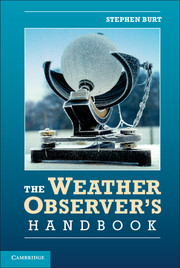Book contents
- Frontmatter
- Contents
- Acknowledgements
- Abbreviations, footnotes and references
- Part One The basics
- Part Two Measuring the weather
- 5 Measuring the temperature of the air
- 6 Measuring precipitation
- 7 Measuring atmospheric pressure
- 8 Measuring humidity
- 9 Measuring wind speed and direction
- 10 Measuring grass and earth temperatures
- 11 Measuring sunshine and solar radiation
- 12 Observing hours and time standards
- 13 Dataloggers and AWS software
- 14 Non-instrumental weather observing
- 15 Calibration
- 16 Metadata – what is it, and why is it important?
- Part Three Making the most of your observations
- Appendix 1 Metrology and meteorology: The basics of instrument theory
- Appendix 2 Useful functions
- Appendix 3 Unit conversions
- Appendix 4 Useful sources
- Index
- References
14 - Non-instrumental weather observing
Published online by Cambridge University Press: 05 July 2012
- Frontmatter
- Contents
- Acknowledgements
- Abbreviations, footnotes and references
- Part One The basics
- Part Two Measuring the weather
- 5 Measuring the temperature of the air
- 6 Measuring precipitation
- 7 Measuring atmospheric pressure
- 8 Measuring humidity
- 9 Measuring wind speed and direction
- 10 Measuring grass and earth temperatures
- 11 Measuring sunshine and solar radiation
- 12 Observing hours and time standards
- 13 Dataloggers and AWS software
- 14 Non-instrumental weather observing
- 15 Calibration
- 16 Metadata – what is it, and why is it important?
- Part Three Making the most of your observations
- Appendix 1 Metrology and meteorology: The basics of instrument theory
- Appendix 2 Useful functions
- Appendix 3 Unit conversions
- Appendix 4 Useful sources
- Index
- References
Summary
Instrumental readings are of course vital in making weather observations, but for a complete picture non-instrumental and ‘narrative’ weather observations are as important. This chapter sets out how to make non-instrumental observations, usually performed at a set time, how to document the frequency of various occurrences such as snowfall, thunderstorms, hail and the like, and how best to maintain a useful weather diary.
Observations at set times
The conventions regarding observing hours were set out in Chapter 12. Many weather stations make one ‘morning observation’ daily, typically between 7 and 9 a.m. (nominally 0900 utc in the UK and Ireland). At this ‘morning ob’ instruments are read and reset for the coming 24 hours, and various eye observations made, as detailed below.
As described in more detail in Chapter 12, the importance of a once-daily observation at a set time has declined as AWSs have made it easier to adjust instrumental observations made at other times, or variable times, to the national or regional standard ‘climatological day’ and so greatly simplifying the comparison of observations between sites. Even with an AWS, it is preferable wherever possible to make at least one ‘manual’ observation every day at approximately the same time, as home and work schedules permit.
- Type
- Chapter
- Information
- The Weather Observer's Handbook , pp. 294 - 303Publisher: Cambridge University PressPrint publication year: 2012



